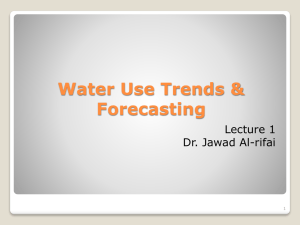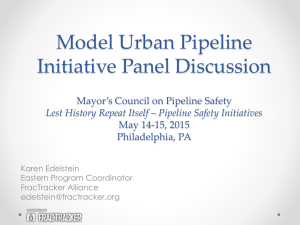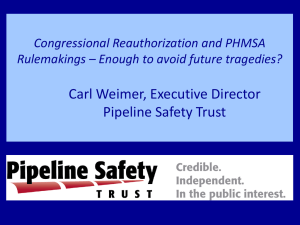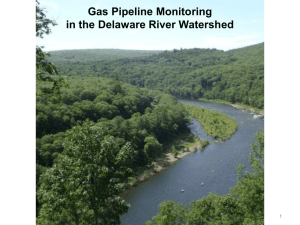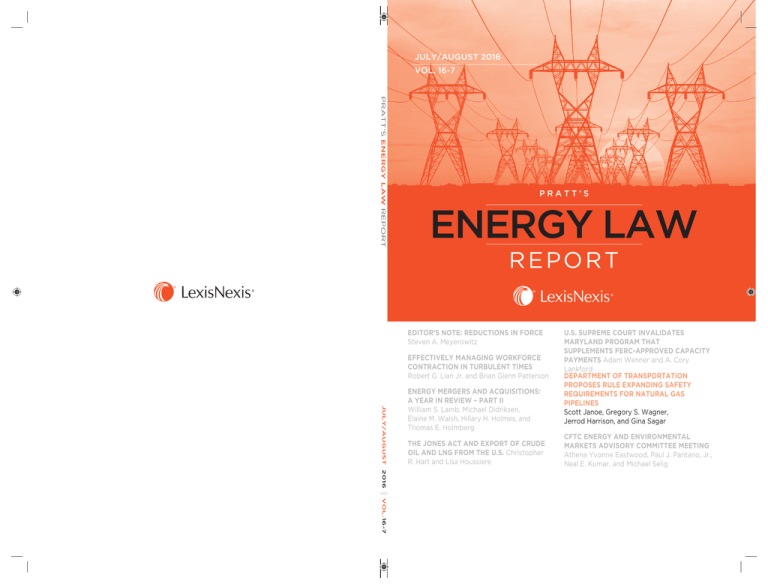
JULY/AUGUST 2016
VOL. 16-7
PRATT’S ENERGY LAW REPORT
PRATT’S
ENERGY LAW
REPORT
EDITOR’S NOTE: REDUCTIONS IN FORCE
Steven A. Meyerowitz
EFFECTIVELY MANAGING WORKFORCE
CONTRACTION IN TURBULENT TIMES
Robert G. Lian Jr. and Brian Glenn Patterson
JULY/AUGUST
ENERGY MERGERS AND ACQUISITIONS:
A YEAR IN REVIEW – PART II
William S. Lamb, Michael Didriksen,
Elaine M. Walsh, Hillary H. Holmes, and
Thomas E. Holmberg
THE JONES ACT AND EXPORT OF CRUDE
OIL AND LNG FROM THE U.S. Christopher
R. Hart and Lisa Houssiere
U.S. SUPREME COURT INVALIDATES
MARYLAND PROGRAM THAT
SUPPLEMENTS FERC-APPROVED CAPACITY
PAYMENTS Adam Wenner and A. Cory
Lankford
DEPARTMENT OF TRANSPORTATION
PROPOSES RULE EXPANDING SAFETY
REQUIREMENTS FOR NATURAL GAS
PIPELINES
Scott Janoe, Gregory S. Wagner,
Jerrod Harrison, and Gina Sagar
CFTC ENERGY AND ENVIRONMENTAL
MARKETS ADVISORY COMMITTEE MEETING
Athena Yvonne Eastwood, Paul J. Pantano, Jr.,
Neal E. Kumar, and Michael Selig
2016
VOL.16-7
0001
[ST: 1] [ED: m] [REL: 16-7] (Beg Group)
Composed: Fri Jun 17 14:28:13 EDT 2016
XPP 8.4C.1 SP #3 FM000150 nllp 1898 [PW=468pt PD=702pt TW=336pt TD=528pt]
VER: [FM000150-Local:09 Sep 14 16:11][MX-SECNDARY: 10 Jun 16 07:46][TT-: 23 Sep 11 07:01 loc=usa unit=01898-fmvol016]
0
Pratt’s Energy Law Report
VOLUME 16
NUMBER 7
JULY/AUGUST 2016
Editor’s Note: Reductions in Force
Steven A. Meyerowitz
247
Effectively Managing Workforce Contraction in Turbulent Times
Robert G. Lian Jr. and Brian Glenn Patterson
249
Energy Mergers and Acquisitions: A Year in Review—Part II
William S. Lamb, Michael Didriksen, Elaine M. Walsh, Hillary H. Holmes, and
Thomas E. Holmberg
256
The Jones Act and Export of Crude Oil and LNG from the U.S.
Christopher R. Hart and Lisa Houssiere
278
U.S. Supreme Court Invalidates Maryland Program That Supplements FERCApproved Capacity Payments
Adam Wenner and A. Cory Lankford
281
Department of Transportation Proposes Rule Expanding Safety Requirements
for Natural Gas Pipelines
Scott Janoe, Gregory S. Wagner, Jerrod Harrison, and Gina Sagar
284
CFTC Energy and Environmental Markets Advisory Committee Meeting
Athena Yvonne Eastwood, Paul J. Pantano, Jr., Neal E. Kumar, and
Michael Selig
289
0002
[ST: 1] [ED: m] [REL: 16-7]
Composed: Fri Jun 17 14:28:13 EDT 2016
XPP 8.4C.1 SP #3 FM000150 nllp 1898 [PW=468pt PD=702pt TW=336pt TD=528pt]
VER: [FM000150-Local:09 Sep 14 16:11][MX-SECNDARY: 10 Jun 16 07:46][TT-: 23 Sep 11 07:01 loc=usa unit=01898-fmvol016]
43
QUESTIONS ABOUT THIS PUBLICATION?
For questions about the Editorial Content appearing in these volumes or reprint permission,
please email:
Jacqueline M. Morris at ............................................................................... (908) 673-1528
Email: ............................................................................... jacqueline.m.morris@lexisnexis.com
For assistance with replacement pages, shipments, billing or other customer service matters,
please call:
Customer Services Department at . . . . . . . . . . . . . . . . . . . . . . . . . . . (800) 833-9844
Outside the United States and Canada, please call . . . . . . . . . . . . . . . . (518) 487-3000
Fax Number . . . . . . . . . . . . . . . . . . . . . . . . . . . . . . . . . . . . . . . . (518) 487-3584
Customer Service Web site . . . . . . . . . . . . . . . . . . . http://www.lexisnexis.com/custserv/
For information on other Matthew Bender publications, please call
Your account manager or . . . . . . . . . . . . . . . . . . . . . . . . . . . . . . . . (800) 223-1940
Outside the United States and Canada, please call . . . . . . . . . . . . . . . . . (518) 487-3000
ISBN: 978-1-6328-0836-3 (print)
ISBN: 978-1-6328-0837-0 (ebook)
ISSN: 2374-3395 (print)
ISSN: 2374-3409 (online)
Cite this publication as:
[author name], [article title], [vol. no.] PRATT’S ENERGY LAW REPORT [page number]
(LexisNexis A.S. Pratt);
Ian Coles, Rare Earth Elements: Deep Sea Mining and the Law of the Sea, 14 PRATT’S ENERGY
LAW REPORT 4 (LexisNexis A.S. Pratt)
This publication is sold with the understanding that the publisher is not engaged in rendering legal,
accounting, or other professional services. If legal advice or other expert assistance is required, the services of
a competent professional should be sought.
LexisNexis and the Knowledge Burst logo are registered trademarks of Reed Elsevier Properties Inc., used
under license. A.S. Pratt is a registered trademark of Reed Elsevier Properties SA, used under license.
Copyright © 2016 Reed Elsevier Properties SA, used under license by Matthew Bender & Company, Inc.
All Rights Reserved.
No copyright is claimed by LexisNexis, Matthew Bender & Company, Inc., or Reed Elsevier Properties SA,
in the text of statutes, regulations, and excerpts from court opinions quoted within this work. Permission to
copy material may be licensed for a fee from the Copyright Clearance Center, 222 Rosewood Drive, Danvers,
Mass. 01923, telephone (978) 750-8400.
An A.S. Pratt® Publication
Editorial Office
230 Park Ave., 7th Floor, New York, NY 10169 (800) 543-6862
www.lexisnexis.com
(2016–Pub.1898)
0003
[ST: 1] [ED: m] [REL: 16-7]
Composed: Fri Jun 17 14:28:13 EDT 2016
XPP 8.4C.1 SP #3 FM000150 nllp 1898 [PW=468pt PD=702pt TW=336pt TD=528pt]
VER: [FM000150-Local:09 Sep 14 16:11][MX-SECNDARY: 10 Jun 16 07:46][TT-: 23 Sep 11 07:01 loc=usa unit=01898-fmvol016]
36
Editor-in-Chief, Editor & Board of
Editors
EDITOR-IN-CHIEF
STEVEN A. MEYEROWITZ
President, Meyerowitz Communications Inc.
EDITOR
VICTORIA PRUSSEN SPEARS
Senior Vice President, Meyerowitz Communications Inc.
BOARD OF EDITORS
SAMUEL B. BOXERMAN
Partner, Sidley Austin LLP
ANDREW CALDER
Partner, Kirkland & Ellis LLP
M. SETH GINTHER
Partner, Hirschler Fleischer, P.C.
R. TODD JOHNSON
Partner, Jones Day
BARCLAY NICHOLSON
Partner, Norton Rose Fulbright
BRADLEY A. WALKER
Counsel, Buchanan Ingersoll & Rooney PC
ELAINE M. WALSH
Partner, Baker Botts L.L.P.
SEAN T. WHEELER
Partner, Latham & Watkins LLP
WANDA B. WHIGHAM
Senior Counsel, Holland & Knight LLP
Hydraulic Fracturing Developments
ERIC ROTHENBERG
Partner, O’Melveny & Myers LLP
iii
0004
[ST: 1] [ED: m] [REL: 16-7]
Composed: Fri Jun 17 14:28:13 EDT 2016
XPP 8.4C.1 SP #3 FM000150 nllp 1898 [PW=468pt PD=702pt TW=336pt TD=528pt]
VER: [FM000150-Local:09 Sep 14 16:11][MX-SECNDARY: 10 Jun 16 07:46][TT-: 23 Sep 11 07:01 loc=usa unit=01898-fmvol016]
22
Pratt’s Energy Law Report is published 10 times a year by Matthew Bender & Company, Inc.
Periodicals Postage Paid at Washington, D.C., and at additional mailing offices. Copyright 2016
Reed Elsevier Properties SA, used under license by Matthew Bender & Company, Inc. No part
of this journal may be reproduced in any form—by microfilm, xerography, or otherwise—or
incorporated into any information retrieval system without the written permission of the
copyright owner. For customer support, please contact LexisNexis Matthew Bender, 1275
Broadway, Albany, NY 12204 or e-mail Customer.Support@lexisnexis.com. Direct any editorial
inquires and send any material for publication to Steven A. Meyerowitz, Editor-in-Chief,
Meyerowitz Communications Inc., 26910 Grand Central Parkway Suite 18R, Floral Park, New
York 11005, smeyerowitz@meyerowitzcommunications.com, 347.235.0882. Material for publication is welcomed—articles, decisions, or other items of interest to lawyers and law firms,
in-house energy counsel, government lawyers, senior business executives, and anyone interested
in energy-related environmental preservation, the laws governing cutting-edge alternative energy
technologies, and legal developments affecting traditional and new energy providers. This
publication is designed to be accurate and authoritative, but neither the publisher nor the authors
are rendering legal, accounting, or other professional services in this publication. If legal or other
expert advice is desired, retain the services of an appropriate professional. The articles and
columns reflect only the present considerations and views of the authors and do not necessarily
reflect those of the firms or organizations with which they are affiliated, any of the former or
present clients of the authors or their firms or organizations, or the editors or publisher.
POSTMASTER: Send address changes to Pratt’s Energy Law Report, LexisNexis Matthew
Bender, 121 Chanlon Road, North Building, New Providence, NJ 07974.
iv
0038
Composed: Fri Jun 17 14:28:25 EDT 2016
[ST: 247] [ED: 100000] [REL: 16-7]
XPP 8.4C.1 SP #3 SC_00052 nllp 1898 [PW=468pt PD=702pt TW=336pt TD=528pt]
VER: [SC_00052-Local:26 May 16 16:49][MX-SECNDARY: 10 Jun 16 07:46][TT-: 23 Sep 11 07:01 loc=usa unit=01898-ch1607]
0
PRATT ’S ENERGY LAW REPORT
Department of Transportation Proposes Rule
Expanding Safety Requirements for Natural
Gas Pipelines
By Scott Janoe, Gregory S. Wagner, Jerrod Harrison, and Gina Sagar*
The authors of this article discuss the Department of Transportation’s
Pipeline and Hazardous Materials Safety Administration Notice of
Proposed Rulemaking intended to update and to supplement safety
requirements for natural gas transmission and gathering pipelines.
The volume of hazardous liquids and natural gas transported by pipeline in
the U.S. has significantly increased as a result of the rapid growth in domestic
energy production. Along with this rapid growth in energy production has
come increased concern over the potential for pipeline safety incidents. The
Department of Transportation’s Pipeline and Hazardous Materials Safety
Administration (“PHMSA”) issued a Notice of Proposed Rulemaking
(“NOPR” or the “Proposed Rule”) intended to update and to supplement safety
requirements for natural gas transmission and gathering pipelines.1 The NOPR
addresses four congressional mandates established by the Pipeline Safety,
Regulatory Certainty, and Job Creation Act of 2011, six recommendations by
the National Transportation Safety Board, and one Government Accountability
Office recommendation. If implemented in their current form, these proposed
rules will significantly change the scope and increase the costs of compliance for
operators across the country.
SCOPE OF RULEMAKING
The NOPR would significantly expand pipeline safety regulations by
*
Scott Janoe is a partner at Baker Botts L.L.P. and Deputy Department Chair—
Environmental in the firm’s Houston office, where he advises energy, mining, and manufacturing
clients on environmental, health, safety, and transportation matters. Gregory S. Wagner is special
counsel at the firm representing clients in the oil, natural gas, and electricity industries in
regulatory, litigation, and transactional matters. Jerrod Harrison is a senior associate at the firm
handling a variety of transactional and regulatory matters. Gina Sagar is an associate at the firm
advising clients in regulatory and transactional matters relating to the energy industry. The
authors may be reached at scott.janoe@bakerbotts.com, gregory.wagner@bakerbotts.com,
jerrod.harrison@bakerbotts.com, and gina.sagar@bakerbotts.com, respectively.
1
Safety of Gas Transmission and Gathering Pipelines, Pipeline and Hazardous Materials
Safety Administration, 81 Fed. Reg. 20722 (Apr. 8, 2016) available at http://www.phmsa.dot.
gov/portal/site/PHMSA/menuitem.6f23687cf7b00b0f22e4c6962d9c8789/?vgnextoid=
92754a27004c3510VgnVCM100000d2c97898RCRD&vgnextchannel=
3ab0d95c4d037110VgnVCM1000009ed07898RCRD&vgnextfmt=print.
284
0039
[ST: 247] [ED: 100000] [REL: 16-7]
Composed: Fri Jun 17 14:28:25 EDT 2016
XPP 8.4C.1 SP #3 SC_00052 nllp 1898 [PW=468pt PD=702pt TW=336pt TD=528pt]
VER: [SC_00052-Local:26 May 16 16:49][MX-SECNDARY: 10 Jun 16 07:46][TT-: 23 Sep 11 07:01 loc=usa unit=01898-ch1607]
0
PROPOSED RULE EXPANDING SAFETY REQUIREMENTS
proposing new assessment and repair criteria for gas transmission pipelines, and
by expanding these requirements to include pipelines located in areas of
medium population density, or Moderate Consequence Areas (“MCAs”).
Specifically, the NOPR proposes changes to integrity management (“IM”) and
non IM requirements that establish how pipeline operators must evaluate and
repair the integrity of transmission pipelines that could affect High Consequence Areas (“HCAs”) and would increase requirements for monitoring and
inspection of pipeline segments located outside of HCAs. The NOPR also
proposes to expand the regulation of onshore gas gathering lines by repealing
currently effective exemptions from reporting obligations.
PREVENTIVE AND MITIGATIVE MEASURES FOR PIPELINE
SEGMENTS IN HCAs
The NOPR proposes to clarify the guidance for risk analyses that operators
use to evaluate and select additional preventive and mitigative measures.
Additionally, the Proposed Rule expands the preventive and mitigative measures
that operators must consider, requires that operators analyze seismicity to
mitigate the threat of outside force damage, and adds specific enhanced
measures for managing external and internal corrosion inside HCAs.
With respect to internal and external corrosion control, the proposed rules
would require operators to conduct periodic close-interval surveys, coating
surveys, interference surveys, and gas-quality monitoring for facilities inside
HCAs. PHMSA intends to address preventive and mitigative measures regarding leak detection and automatic valve upgrades in subsequent rulemakings.
MODIFYING REPAIR CRITERIA
The NOPR proposes to revise the repair criteria for pipelines in HCAs,
including repair criteria for cracks and crack-like defects, corrosion metal loss,
and mechanical damage defects. The NOPR also proposes to establish repair
criteria for pipelines that are outside of HCAs. Generally, PHMSA proposes to
add more immediate repair conditions and more one-year repair conditions for
HCA segments. PHMSA is also proposing to apply similar repair criteria in
non-HCA segments, with the exception that response times will be tiered, with
longer response times for non-immediate conditions.
IMPROVING REQUIREMENTS FOR COLLECTING, VALIDATING,
AND INTEGRATING PIPELINE DATA
The NOPR proposes to clarify the requirements for collecting, validating
and integrating pipeline data and would establish attributes that must be
included in pipeline data. Specifically, the NOPR would explicitly require that
operators analyze and integrate pipeline data into IM risk assessment and other
analyses of pipeline integrity. Further, the NOPR proposes that data be verified
285
0040
[ST: 247] [ED: 100000] [REL: 16-7]
Composed: Fri Jun 17 14:28:25 EDT 2016
XPP 8.4C.1 SP #3 SC_00052 nllp 1898 [PW=468pt PD=702pt TW=336pt TD=528pt]
VER: [SC_00052-Local:26 May 16 16:49][MX-SECNDARY: 10 Jun 16 07:46][TT-: 23 Sep 11 07:01 loc=usa unit=01898-ch1607]
0
PRATT ’S ENERGY LAW REPORT
and validated and would impose new requirements to ensure that records used
to establish the Maximum Allowable Operating Pressure (“MAOP”) are
reliable, traceable, verifiable, and complete.
INCREASING REQUIREMENTS ON THE SELECTION AND USE
OF ASSESSMENT METHODS
After HCAs are identified, operators are required to use one or more
assessment methods to measure for corrosion, deformations, cracking, or other
hazards that could reduce integrity to a point where protection against leakage
or rupture cannot be assured. Pipeline operators must perform assessments and
prioritize necessary repairs. The NOPR proposes to strengthen requirements for
the selection and use of assessment methods by adding more specific requirements for internal inspection tools, and by requiring operators to explicitly
consider uncertainties in reported results, including those due to uncertainties
in the model and the data used in the risk assessment (i.e., tool tolerance,
detection threshold, probability of detection, probability of identification,
sizing accuracy, conservative anomaly interaction criteria, location accuracy,
anomaly findings, and unity chart plots or equivalent for determining
uncertainties and verifying actual tool performance). The Proposed Rule would
require that direct assessment (i.e., an integrity assessment method limited to
evaluating external corrosion, internal corrosion, and stress corrosion cracking)
only be allowed when the pipeline cannot be assessed using in-line inspection
tools.
EXPANSION OF REGULATIONS TO MODERATE CONSEQUENCE
AREAS
The NOPR proposes to expand certain IM requirements beyond HCAs to
MCAs. PHMSA would require periodic integrity assessments, material documentation verification, and MAOP verification in the new locations. An MCA
would be defined as an onshore area that is within a potential impact circle
containing five or more buildings intended for human occupancy, an occupied
site, or a right-of-way for a designated interstate, freeway, expressway, and other
principal four-lane arterial roadways, as defined by the Federal Highway
Administration, which does not meet the definition of an HCA.
The Proposed Rule would apply only three IM program elements (assessment, periodic assessment, and remediation of discovered defects) to MCAs
because of the significant additional costs of applying all IM program elements
to additional segments to non-HCA areas. However, PHMSA is seeking
comments on the merits of expanding HCAs versus creating a new category of
MCAs, as well as on the costs and benefits attributable to shorter and longer
initial assessment periods and re-assessment intervals.
286
0041
[ST: 247] [ED: 100000] [REL: 16-7]
Composed: Fri Jun 17 14:28:25 EDT 2016
XPP 8.4C.1 SP #3 SC_00052 nllp 1898 [PW=468pt PD=702pt TW=336pt TD=528pt]
VER: [SC_00052-Local:26 May 16 16:49][MX-SECNDARY: 10 Jun 16 07:46][TT-: 23 Sep 11 07:01 loc=usa unit=01898-ch1607]
0
PROPOSED RULE EXPANDING SAFETY REQUIREMENTS
REGULATION OF PREVIOUSLY EXEMPT FACILITIES
The NOPR proposes requirements for verification of MAOP for certain
onshore, steel, gas transmission pipelines, including establishing and documenting MAOP for the life of the pipeline and confirming and recording the
physical and operational characteristics of pipelines for which adequate records
are not available. Under the Proposed Rule, operators of gas transmission lines,
including those built before 1970 that were previously exempted, that are
located in an HCA or MCA and meet certain conditions must re-establish and
document their MAOP. Specifically, this would apply to pipelines located in an
HCA or MCA that have experienced a reportable in-service incident since their
most recent subpart J pressure test due to an original manufacturing-related
defect, a construction-, installation-, or fabrication-related defect, or a crackingrelated defect, have pressure test records necessary to establish MAOP that are
not reliable, traceable, verifiable, and complete, or have an MAOP that was
established in accordance with § 192.619 before the effective date of the rule.
INCREASED REGULATION OF GAS GATHERING LINES
Currently, onshore gas gathering pipelines are exempt from reporting of
incidents, safety-related conditions, and annual pipeline summary data. However, with gathering lines up to 36 inches in diameter and with MAOPs up to
1480 psig being constructed to transport shale gas, gathering lines may pose
similar safety risks as transmission lines. Accordingly, the NOPR proposes to
repeal the exemption for reporting requirements for gas gathering line
operators, repeal the use of API RP 80 for determining regulated onshore
gathering lines, and add new definitions for regulated onshore gathering lines.
IMPLICATIONS
The highly-anticipated NOPR would significantly expand PHMSA’s jurisdiction over many additional miles of pipeline, including pipelines constructed
prior to 1970 and previously exempt from PHMSA’s regulations, additional
natural gas gathering lines, and pipelines located in moderately populated areas.
The Proposed Rule also would impose additional requirements associated with
IM repair criteria, direct assessment methods, and internal and external
corrosion control. This would require operators to commit considerable
operational and administrative resources to identifying, assessing newly regulated pipeline assets and compiling the associated documentation. Industry
participants have already expressed concern over the costs and potential service
disruptions associated with the implementation of these new requirements.
There are additional implications for pipelines subject to rate regulation.
Pipelines within the jurisdiction of the Federal Energy Regulatory Commission
(“FERC”) are generally permitted to pass on costs attributable to safety
measures directly to shippers without exposing the pipeline’s full rates to
287
0042
[ST: 247] [ED: 100000] [REL: 16-7]
Composed: Fri Jun 17 14:28:25 EDT 2016
XPP 8.4C.1 SP #3 SC_00052 nllp 1898 [PW=468pt PD=702pt TW=336pt TD=528pt]
VER: [SC_00052-Local:26 May 16 16:49][MX-SECNDARY: 10 Jun 16 07:46][TT-: 23 Sep 11 07:01 loc=usa unit=01898-ch1607]
0
PRATT ’S ENERGY LAW REPORT
regulatory review. This is likely to required increase participation before FERC
for both pipelines and their shippers, though not to the degree required for a
full cost-of-service rate case, as well as increased transportation rates for those
shippers paying recourse rates. In those states that actively regulate intrastate
transportation or gathering fees, we would expect an uptick in rate filings or
disputes as pipeline seek to recover the increased costs of compliance,
particularly with respect to facilities previously outside of PHMSA’s jurisdiction.
288

